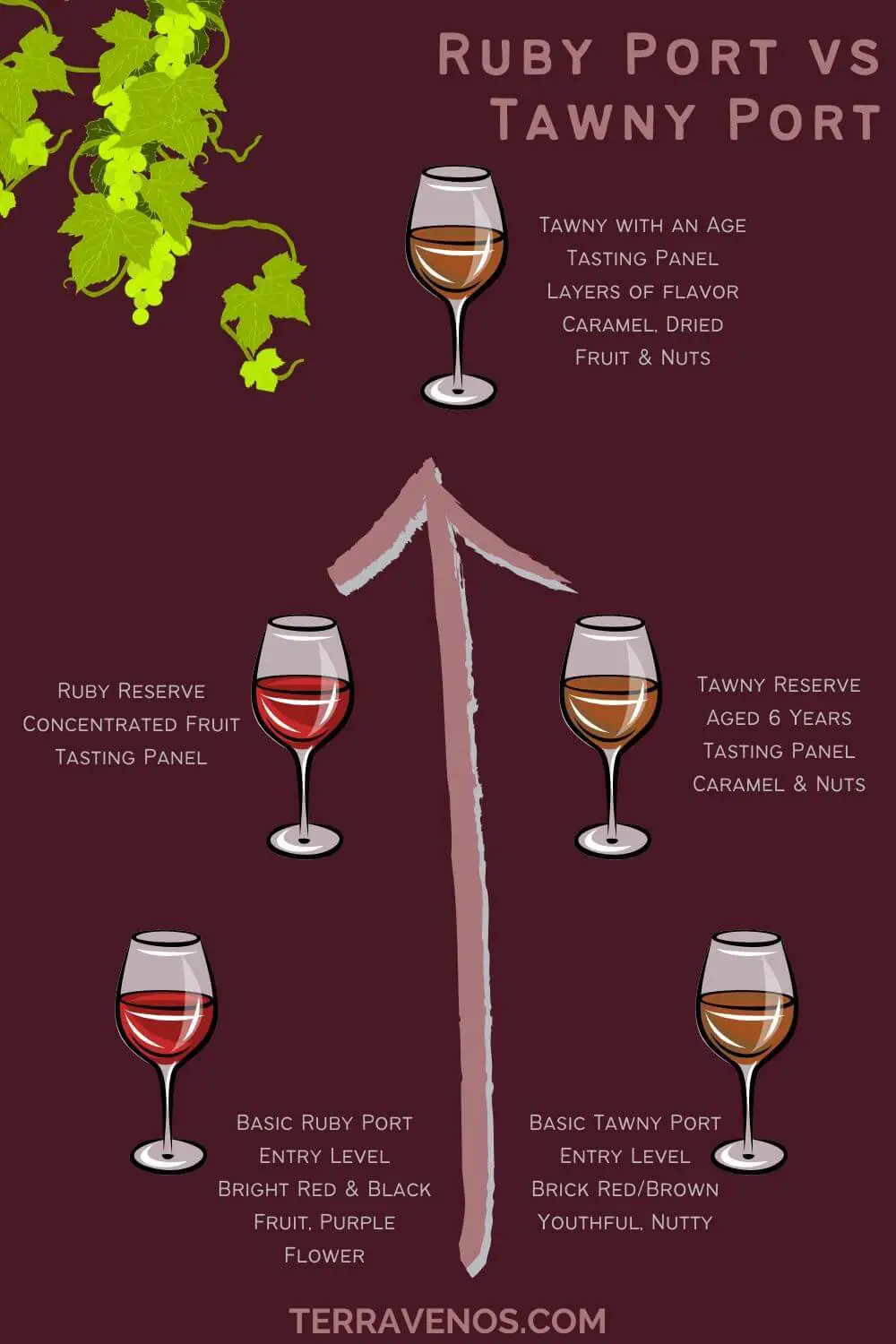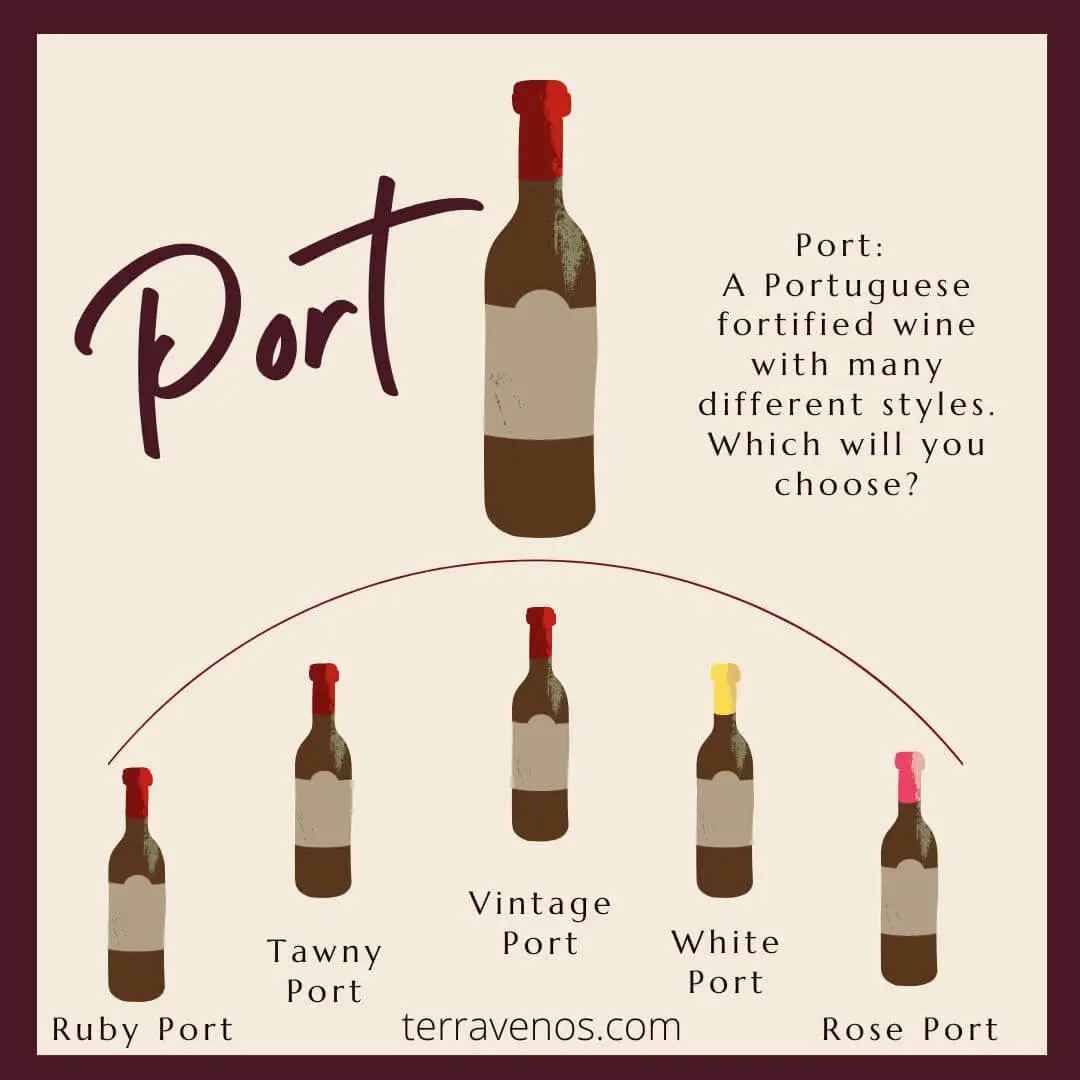
Port is one of those wines that sneaks up on you and leaves you asking: Where have you been all my life? You’ll two styles in particular, Ruby and Tawny, widely available, but what’s the difference?
Ruby Port and basic Tawny Port are both entry-level, sweet fortified wines. Ruby Port is fruit-forward with a deep ruby color. Tawny Port is brick red and nutty. But aged Tawny Ports are of higher quality with caramel and nuts. It’s worth knowing different Port styles to pick the right bottle.
Here’s a breakdown of the different styles of Ruby Port, Tawny Port, and Aged Tawny Port – along with a chart to help you sort out these many different Port styles.
What Is Port Wine?
Port wine, often just called “Port” is a fortified wine made in the Douro Valley of Portugal.
Port wines are always sweet, and typically red. Port’s fortified with distilled spirits which raise the alcohol level to 19%-22% alcohol by volume. Renowned the world over, Port has a reputation for being a powerhouse of a wine with rich layers of flavor, a full body, and lingering notes of candy and fruit.
Think of Port as the umbrella category.
There are several different styles of Port, including Tawny Port, Vintage Port, and Ruby Port (of course), among others. You can even find White Port and Rosé Port, but these are uncommon.
Each Port style has its own unique characteristics and flavor profile.

What Is Ruby Port?
Ruby Port is the least expensive style of Port wine. It’s made to be early drinking with pronounced red and black fruit, purple flower, and candied licorice notes.
Ruby Port is always a blend of grapes and a blend of vintages. Ruby Ports are released 2 to 3 years after harvest.
Helpful Tip: There’s lots to know about Port, so I put together this in-depth overview of how Port wines get made. Check it out!
Stylistically, Ruby Ports are generally considered to be more straightforward, more approachable, and less complex than some of the other styles, like Vintage Ports or Age-Indicated Tawny Ports.
Port houses, like Croft and Graham’s, want their Ruby Ports to taste the same every year so that their customers know exactly what their Port wine will taste like.
Helpful Wine Drinking Tip: Here’s a quick guide of 12 perfect food pairings for Ruby Port wines – go check it out!
What’s Ruby Reserve Port?
Ruby Reserve has more flavor concentration than basic Ruby Port. This wine goes through a tasting panel to verify quality.
Expect to pay a little more money for a Ruby Reserve but it’s worth it if you have the wine budget. Ruby Reserve Ports are one quality level up from basic Ruby Port.
What Is Tawny Port?
Tawny Port is a style of Port wine that is characterized by its amber color and nutty flavors. Like Ruby Port, Tawny Port comes in different quality levels: Basic Tawny, Tawny Reserve, and Age-Indicated Tawny (the highest category). Here’s a breakdown for you:
- Basic Tawny Port: A blend of different vintages, always sweet, paler in color than Ruby Port, and not as concentrated as Ruby Port. The color comes from manipulating the winemaking process, not from long aging (think of this like the cheap knock-off to a true Tawny Port).
- Tawny Reserve Port: Now things get interesting. Aged for a minimum of 6 years in wood giving it that lighter color and caramel notes. Tawny Reserves have to go through a tasting panel. Tawny Reserves have rich flavor concentration and will be more expensive than Basic Tawny Ports.
- Tawny Port with an Age Indication: These are the Tawnies worth celebrating! They are aged in small wooden barrels called pipes, for 10, 20, 30, or even 40 years (you’ll see this on the label). Tawny Ports with an age indication are usually a blend of vintages and will have layers of complex fruit, licorice, nuts, spice, and caramel. Aged Tawny Ports are the highest quality in the Tawny sub-category of Ports and go through a tasting panel to verify their quality. Expect to pay a premium for aged Tawny Ports.
Helpful Tip: Here’s a more in-depth post on everything related to Tawny Port wine and what the different styles taste like (just incase you’re curious).
Ruby Port vs Tawny: What’s the Difference?
You can see from the image above that Ruby Ports forefront red and black fruits and Tawny Ports showcase nuts and caramel. Both wines are sweet and spirity, but they profile different characteristics in the wine through their distinctive winemaking processes.
| Aspect | Basic Ruby Port | Basic Tawny Port |
|---|---|---|
| Color | Deep red/purple | Brownish-red, paler |
| Flavor Profile | Rich, fruity, robust | Nutty, caramel, smoother |
| Tannins | High tannins | High Tannins |
Is Tawny or Ruby Port better?
If you like fruit-forward wines, then you’ll like Ruby Port. If you enjoy caramel and nuts in addition to fruit, then try a Tawny Port. If you want to save money, then Ruby Ports are the least expensive Port wine style. If you want higher quality, then aged Tawny Ports are the best.
Remember: There’s not much of a quality difference between a basic Ruby Port and a basic Tawny Port. At a minimum, stick with “Reserve” Rubies and Tawnies. It’s the quality level where things start to get interesting.
On a personal note, my favorite Ports are aged Tawnies. They can develop layers of complexity like leather, nuts, dried fruit, even black tea – all surprising in a wine.
Helpful Tip: Get the most out of your Port wine regardless of style. Here’s a rundown of what wine glasses you should be using when drinking Port wines (and also creative substitutes if you don’t have a full wine bar). Yes. Glasses matter when it comes to Port.
Final Thoughts – Ruby vs Tawn Port: Two Wines Worth Trying!
Ruby Ports are excellent gateway wines to the fortified wine world. They’re like sweet, spirity red wines. You’ll find many similar flavors and aromas to your typical red wine, like berries and floral notes.
Tawny Ports offer the drinker that aged wine experience, with tertiary notes of nuts and caramel. If you love old wines, then you’ll definitely enjoy Tawny Port!
Thirsty for More?
Check out this post on Ruby Port FAQs for a quick summary of this powerhouse red wine.
Fortified Wines. Where to start? Here’s how to know if your wine is fortified (or not).
Here’s a great post that will tell you how to pick out a good fortified wine.
And I wrote this post to as a quick comparison between fortified and nonfortified wines.



